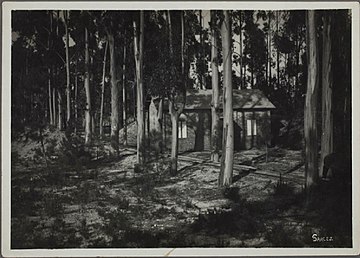Fábrica de Pólvora de Vale de Milhaços
The Fábrica de Pólvora de Vale de Milhaços was an explosives factory operated from 1895 to 2001 in the municipality of Corroios , Seixal district in Portugal .
history
Augusto de Oliveira, built in 1895 on an eleven-hectare estate in Vale de Milhaço de Baixo in the municipality Corroios a gunpowder factory . It was in a pine forest , far from the isolated farms and villages that are typical of the area.
The license granted in 1894 went to the company Francisco Carneiro & Comandita (1896–1898) and soon afterwards to the Companhia Africana de Pólvora, SARL (1898–1921). After an explosion on April 3, 1897, the factory was rebuilt according to a new, revolutionary industrial plan for the time.
The Companhia Africana de Pólvora was founded with German capital and maintained a very strict management between the end of the 19th century and the First World War. The explosives factory Vale de Milhaços benefited from the decree on the liberalization of the gunpowder industry and the arms trade in Portugal of June 23, 1879. The Portuguese colonization of Africa , which was intensified again in the course of the international race for Africa , provided the incentive for the production of ordinary, non-military explosives for use in quarries and mines, for the construction of railways, public buildings and seaports in Angola .
| Light railway of the powder factory in the Milhaços Valley | |
|---|---|
|
Light rail in the eucalyptus forest at storage shed No. 23 of
the Fábrica de Pólvora de Vale de Milhaços | |
|
Light railway (gray line) and transmission belt (black line with dots)
| |
| Gauge : | 600 mm ( narrow gauge ) |
Between 1898 and 1910 the property was enlarged to 21.5 hectares. Black powder production of the África type was 2500 kg / day and was intended for the African and Portuguese markets. A light railway, probably a Decauville railway, located in a eucalyptus forest , connected the factory with the black powder drying plant and the storage shed. The lease of the port of Rouxinol following Corroios guaranteed an effective way of getting your products to the port of shipment in Lisbon .
Portugal's entry into World War I had an immediate impact on the Companhia Africana de Pólvora, for both political and economic reasons. The beginning of the international confrontations in Africa led to the restriction of the explosives trade in Angola. After the Great Depression from 1919 to 1921, the company was dissolved and the properties were sold. Then the Sociedade Africana de Pólvora. founded as a family company under the management of Francisco Camelo.
This company was active from 1922 to 2001. At the beginning of the 1980s, a steam engine with 125 hp, built by Joseph Farcot & Fils in 1900, was still in operation there. For safety reasons, the engine room was isolated from the other workshops. It was the heart of the system and supplied the workshops with energy via transmission belts , cables and an elevated steam line. For safety reasons it was isolated from the other workshops.
After its closure, the industrial complex was temporarily taken over by the Association for Industrial Archeology of the Lisbon Region ( Associação de Arqueologia Industrial da Região de Lisboa ) and the Seixal Ecomuseum, founded in 1982. Since the factory's centenary in 1998, the Seixal Ecomuseum has been aware of the factory's financial situation and its intention to close, and has since led the campaign to raise awareness and promote cultural visits. After the closure, part of the facility was separated from the complex. The historically most important remains of the industrial plant ended up in the possession of the Seixal municipality, which operates the Seixal Ecomuseum.
Individual evidence
- ↑ a b Jorge Custódio: A Fábricade Pólvora de Vale de MilhaçosSingularidade e inovação de um complexo fabril do património industrial português.
- ^ Fábrica Africana da Pólvora de Vale de Milhaços. Portuguese YouTube video. Light rail tracks at 6:53, 7:05 and 9:15.
- ^ Fábrica de Pólvora de Vale de Milhaços.
Coordinates: 38 ° 37 '9.4 " N , 9 ° 9' 51.7" W.

